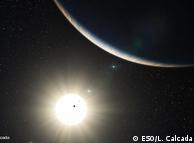Scientists at the
European Southern Observatory, or ESO, announced the discovery of the
richest known extrasolar planetary system on Tuesday. After six years of
study, ESO published its findings that at least five confirmed
exoplanets, or extrasolar planets, are orbiting a star only 127 light
years away from Earth.
The five exoplanets
all have approximately the mass of Neptune - between 13 and 25 times the
mass of Earth - but orbit much closer to their star, with orbital
periods between six and 600 days (Neptune takes 164.79 years to orbit
the Sun).
In addition to the
five Neptune-sized planets, ESO astronomers have "tantalizing" evidence
of two more exoplanets in the system. One is Saturn-sized, with an
orbital period of 2,200 days and the other is the smallest known
exoplanet with merely 1.4 Earth masses and an orbital period of only
1.18 days.
The Sun-like star,
which is called HD 10180, is located in the southern constellation
Hydrus, and has been studied closely since its discovery with the HARPS
spectrograph in La Silla, Chile. The existence of the exoplanets was
discovered through gravitational wobbles in the behavior of the star
caused by the passage of the planets.
 Bildunterschrift: The newly discovered system is only 127 light years from Earth
Bildunterschrift: The newly discovered system is only 127 light years from Earth
Familiar traits observed
Using data from this
new discovery as well as data from other planetary systems, the
researchers found evidence of the Titius-Bode law that exists in our
solar system: The distances of the planets from their star seem to
follow a regular pattern.
"This could be a
signature of the formation process of these planetary systems," team
member Michel Mayor said in the ESO press release.
ESO astronomer Christophe Lovis also acknowledged that this discovery highlights the changes in the field of exoplanet research.
"We are now entering a
new era in exoplanet research: The study of complex planetary systems
and not just of individual planets," Lovis said. "Studies of planetary
motions in the new system reveal complex gravitational interactions
between the planets and give us insights into the long-term evolution of
the system."
Through further study
of the system around HD 10180, ESO astronomers hope to learn more about
planetary formation and about how the solar system was developed, as
well as what its future may look like.
Author: Stuart Tiffen (AP/AFP)
Editor: Kate Bowen
http://www.dw-world.de/dw/article/0,,5942537,00.htm









